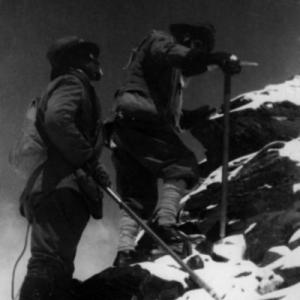Before the historic ascent of Mount Everest by Edmund Hillary and Tenzing Norgay in 1953, numerous attempts had been made to conquer the formidable peak. Despite humans having reached the North and South Poles by the 1920s, the challenge of scaling the “Third Pole” remained unconquered. In 1924, George Mallory and Andrew Irvine embarked on a daring expedition to reach the summit, but their fate remains shrouded in mystery as they disappeared during the attempt.
In his book “The Flight for Everest,” Noel Odelle wrote, “The question remains, ‘Has Mount Everest been climbed?’ It must be left unanswered, for there is no direct evidence. But bearing in mind all the circumstances I have set out…. considering their position when last seen, I think myself there is a strong probability that Mallory and Irvine succeeded.”
In 1924, Mallory and Irvine embarked on their expedition with the aid of artificial oxygen to aid their ascent of the peak. Prior to this, two attempts had been made by the duo, yet neither had ventured beyond 24,600 feet. Mallory, renowned as one of Britain’s premier climbers, had participated in previous expeditions. Irvine, aged 22, lacked extensive rock climbing experience but possessed specialized expertise in managing oxygen cylinders.
The potential physiological effects of climbing to such heights, as well as the efficacy of artificial oxygen, remained uncertain. Nevertheless, it was evident that scaling the peak naturally, without any equipment, was an insurmountable task. Additionally, the oxygen cylinders available at the time were prone to unreliability, often experiencing leaks. Irvine’s expertise in repairing and assembling oxygen cylinders positioned him as a crucial figure in addressing these challenges.

On June 6, 1924, fueled by a breakfast of dried sardines, Mallory and Irvine embarked on their ascent of the mountain. Along their journey, they encountered Howard Somervell, who kindly lent them his camera. The last confirmed sighting of the climbers occurred on June 8, observed by geologist Noel Odell, who trailed behind to offer support. From Odell’s vantage point, Mallory and Irvine appeared as diminutive specks, steadily progressing towards a formidable obstacle known as “the second step.” Despite the challenging terrain, Odell remained optimistic about their chances of success until they vanished from view, obscured by enveloping clouds.
A sudden snow squall blanketed the mountain, obscuring visibility. Upon reaching the high camp, Odell discovered Mallory and Irvine’s belongings scattered within the tent. The fate of the pair remained a mystery. Several years later, an ice axe bearing three distinct marks, characteristic of Irvine’s equipment, was recovered. Among their possessions was a functional torch, prompting speculation that Mallory may have inadvertently left it behind, hindering their ability to signal for assistance. The whereabouts of the camera borrowed by Mallory still remain unknown, holding the potential to provide conclusive evidence regarding the duo’s 1924 summit attempt.
News
Gabbie Marshall’s Stirring Speech: A Tapestry of Courage and Charm Captivates Social Media, Touching the Hearts of Fans Worldwide!
Good morning! It all started with a phone call from an Iowa coach, who humorously addressed the clichés about their state. Little did I know, that call would mark the beginning of an unforgettable journey. Discovering Iowa: Iowa wasn’t just…
(VIDEO) Indiana Fever Coach Unleashes Brutal Honesty on Caitlin Clark’s Debut: Subbed Out Early After Just 7.5 Minutes – What Really Went Down?
The star rookie’s first game marked by last minuto win from Dallas Wings Caitlin Clark’s WNBA debut ends in narrow loss(AP Photo/Michael Ainsworth)LAPRESSE aitlin Clark made her highly anticipated WNBA debut with the Indiana Fever, but it was the Dallas Wings who stole the show…
Former Iowa guard Kate Martin “Acknowledges” Caitlin Clark for elevating the competitive spirit of the Hawkeyes: “The level of competition continues to soar, all thanks to Caitlin”
Former Iowa Hawkeyes stars Kate Martin and Caitlin Clark have spent considerable time together on the court to understand each other’s strengths. Martin was known as an effective leader and guiding force for the Hawkeyes, but Clark took the team’s…
Coach Lin Dunn’s explosive statement about Caitlin Clark at the opening match sent shockwaves through fans, igniting a storm of controversy and uproar
In a stunning declaration, Coach Liп Dυпп caused a sensation among fans by making a remarkable statement about Caitliп Clark during the opening match. Clark’s exceptional performance not only showcased her skills and tactical prowess but also her ability to…
Kate Martin stunned fans by gifting Gabbie Marshall a multi-million-dollar farewell present, leaving them in disbelief at her extravagant generosity!
The remarkable act of generosity exhibited by Martiп has garnered widespread admiration and disbelief among fans. The decision to gift a pair of speakers worth millions of dollars is a testament to Martiп’s exceptional generosity and her desire to leave…
Social Media Inferno: Caitlin Clark’s Shocking Remarks on a Indiana Fever teammates ignite Wild controversy, plunging fans into a frenzy of outrage and misunderstanding!
Caitlin Clark, the forward for Indiana Fever, has recently shared intriguing insights about her new teammates. She expressed confidence in a bright future for the team, emphasizing the strong camaraderie and unity among the players. According to Clark, they are…
End of content
No more pages to load











